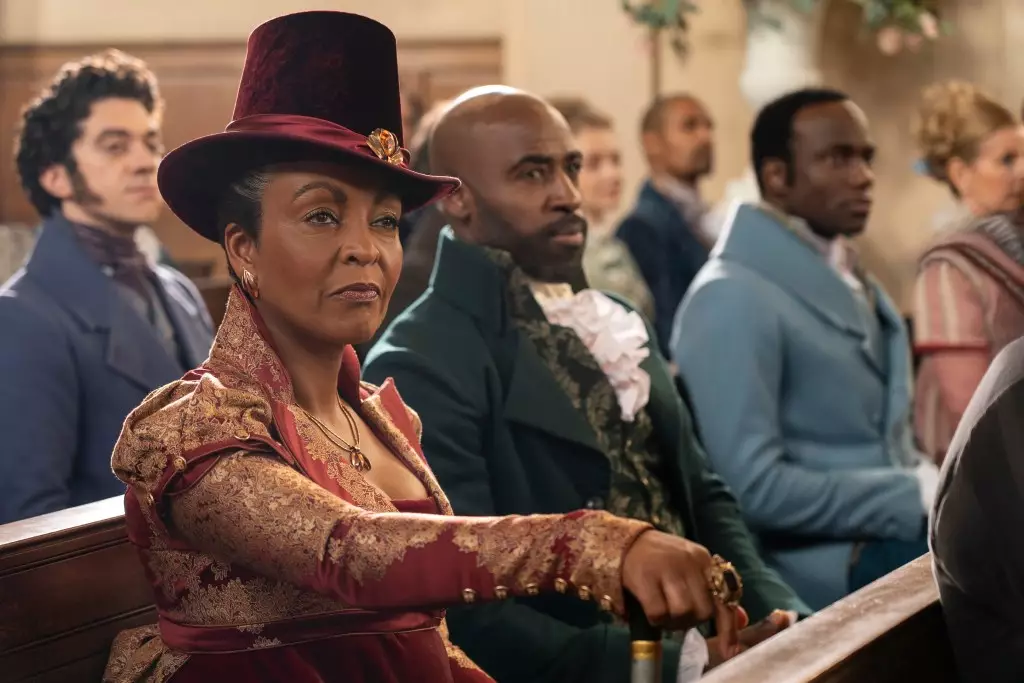In a world increasingly grappling with the implications of representation in media, British actress Adjoa Andoh stands as a formidable voice advocating for diverse storytelling. Known for her unforgettable portrayal of Lady Agatha Danbury in the Netflix hit series Bridgerton, Andoh recently expressed profound admiration for the series creator, Shonda Rhimes. Her acknowledgement of Rhimes as the “queen of long-form narrative” speaks volumes not only about Rhimes’ impact but also underscores the importance of having visionary leaders in storytelling, particularly when it comes to issues of race and representation in period dramas.
Andoh’s insights at the Italian Global Series Festival, where she received the prestigious Maximo Excellence Award, reveal a layered perspective on the narrative choices made in Bridgerton. The actress articulated her excitement about being involved in a project that is not merely an adaptation of Julia Quinn’s best-selling novels, but rather a reimagining of the Regency era, which traditionally has been depicted predominantly through a Eurocentric lens.
The ‘What If?’ Imagination
What makes Rhimes’ work truly groundbreaking is her ability to ask “What if?”—a question that serves as a creative catalyst for innovation. Andoh highlighted this approach when she noted how Rhimes brought the character of Queen Charlotte to life and transformed her race, despite the character’s absence in the source material. This imaginative exercise does not just add layers to the narrative; it also challenges viewers’ preconceived notions about historical accuracy and the exclusivity of the royal narratives that have long dominated television and film.
Andoh’s conviction is clear: the act of diversifying a narrative is not an attempt to rewrite history, but rather to illuminate aspects of history that have been overlooked or entirely marginalized. She firmly stated that Bridgerton and its spin-off, Queen Charlotte, amplify a more inclusive reality that existed. “It didn’t rewrite history. It amplified a history that already existed,” she emphasized, implying that the absence of diverse representation in pre-existing portrayals is not an accurate reflection of historical demographics.
Facing the Future of Diverse Storytelling
Interestingly, Andoh’s remarks were not devoid of a forward-looking perspective. Responding to concerns about a potentially regressive shift in storytelling—an impending danger posed by political climates that can stifle diversity—Andoh remained optimistic. “The shift [to diverse storytelling] has already happened,” she declared, offering a counter-narrative to fears that the success of diverse cinema and television might plateau or even decline.
She underscored the global appeal of diversity in narratives, asserting that contemporary audiences crave stories that are representative of their realities. “Reflect people and they will watch you,” she affirmed. This sentiment extends beyond mere politics; it’s a call to action for artists and creatives worldwide to embrace their unique backgrounds and tell their own stories. Andoh’s assertion resonates at a time when cultural exchange is more accessible than ever, urging creatives to seize the opportunity to share their perspectives.
The Economics of Inclusivity
Andoh deftly connected the creative with the commercial, noting that an increase in diverse storytelling has the power to open up new markets. “It’s also about opening up markets, which is something Trump loves,” she noted with a quip, subtly challenging the often myopic viewpoint held by some regarding the economics of diversity. By embracing a wide array of voices, industries can tap into richer narratives that not only captivate audiences but also drive profitability.
In a world that remains divided in many respects, the call for authentic representation in storytelling is a powerful one. As exemplified by Andoh and her work in Bridgerton, the future of media can— and should— reflect the complexity and richness of our global communities. Storytellers have an imperative to challenge traditional norms and allow a mosaic of experiences to define our past and shape our future. This is more than just a trend; it is an essential evolution in the way we understand and depict the human experience.

